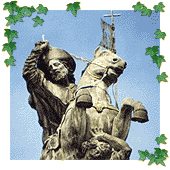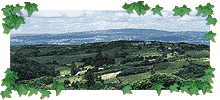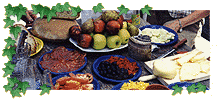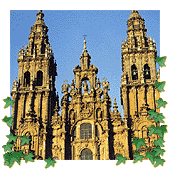 |
 |
 |
|
|||
|
The
Pilgrim's Way When I was in grammar school, my parents, picking up on my fascination with all things medieval, gave me a history of the middle ages entitled The Age of Chivalry. I spent hours thumbing through the lavishly illustrated book, which included a chapter on Santiago de Compostela, a city in northwestern Spain, where the body of St. James the apostle is said to be buried.
According to legend, James ventured to Spain during the first century, preaching the Gospel and was buried there by his followers in a secret location. Eight hundred years later a hermit, attracted by strange lights and heavenly music coming from an old Roman cemetery, discovered the tomb. Soon, news of the discovery spread, and worshipers from all across Europe began making pilgrimages to the spot which became known as Santiago de Compostela, or St. James of the Field of Stars, because of the heavenly lights which guided the old hermit to the place. Today, hundreds of thousands of pilgrims still travel along the Camino de Santiago, or road to Santiago. Last summer, I fulfilled a lifelong dream and joined one such group as a guest of Camino Tours, an American outfit that offers all-inclusive, bicycling and walking tours of Spain, starting at about $2000. After arriving by plane in Madrid, I took a train four hours north to the city of Leon where I rendezvoused with the group, a dozen of us in all. Because we only had a week, we traveled by shuttle van for part of the way, while averaging about ten miles a day on foot. We followed the 450-mile-long Camino Frances, or the French Road, the primary route used by pilgrims who crossed the Pyrenees from France. During the middle ages, these pilgrims often spent the night in convents and monasteries along the way called hospitals. Indeed, the word hospitality has its roots in these institutions. One of the most well-known was Leon's Hospital of San Marcos, a rambling, richly decorated structure that looks more like a palace than a monastery. The monks are gone, but food and rest are still plentiful among the quiet courtyards and gurgling fountains of San Marcos, now a luxurious hotel, where I spent my first night.
After shuttling to the nearby town of Astorga early the next morning, I made my way on foot to the dry and dusty village of Santa Catalina de Somoza, about three miles away. There, I paused at a roadside shop to pick up my pilgrim's badge -- a scallop shell, typically hung around the neck or otherwise displayed on backpacks or clothing. No one's sure how the shells became the pilgrim's symbol. One legend I recalled reading is that St. James, clad in armor made from scallop shells, rose from the sea to inspire the Spaniards onto victory during a decisive battle in 848. Historians believe that pilgrims simply brought a scallop shell home with them as proof of their pilgrimage. I hung my carefully-selected shell from my backpack, and continued on the hot tarmac road. After only a few hours of walking, I began to feel a connection to the brave soles that had walked this path before me. And I don't mean spiritual souls, I mean the soles of my feet were killing me. Fortunately, the scenery helped take my mind off my aching arches. On my eight-and-a-half mile hike that first day I passed nodding fields of wheat and poppies, stone farm houses with straw roofs and flocks of sheep optimistically grazing in sun-scorched pastures.
As for me, I grazed each day on local treats...olives, fresh crusty bread, sheep's cheese, and jamon, delicious Iberian ham cured in country cellars. At night, I joined the group around rough-hewn tavern tables, toasting the day's hike with glasses of aquardiente, an amber-colored, slightly sweet and syrupy wine that sneaks up on you and keeps you laughing and singing long after you should have gone to bed. And so morning comes early on the Camino de Santiago...at least for those who've been drinking aquardiente all night. I was looking forward to the cool mountain air of the province of Galicia, where the dusty flatlands gave way to mountain streams, heather and rich forests of oak and chestnut. A misty land of myth and superstition, Galicia is nicknamed terra megas -- land of the witches. I could have sworn I heard a few singing in a forest the next day, but it turned out to be three middle-aged women from Madrid on pilgrimage. What made them decide to go to Santiago?
One of the reasons I came was to see the medieval churches and monasteries along the way, such as the Monastery of Samos, where I heard vespers, an evening prayer service. While the exteriors of Samos and many of the camino's other churches are either Romanesque or Gothic in style, I was disappointed when I discovered that during the 18th century the interiors had been done over in Baroque, with its lavish gilt altar screens, painted statuary and rococo opulence. Still, others were untouched. I liked these best as I made my way from one village to the next and one town to another along the camino, that switches back and forth from forest path, to country lane, to tarmac road. There were a few minor challenges here and there...rain one day, a worn out pair of shoes the next that sent me on a frantic shopping spree for some new ones. On day seven, after having walked nearly 70 miles, the group and I caught sight of our destination from atop the Monte del Gozo, the Mount of Joy.
They were the spires of Santiago Cathedral glimmering in the distance, less than five miles away. As I gazed at the church, dwarfed now by modern suburban sprawl, I recalled an illustration in my history book that showed a group of pilgrims, overcome with emotion, humbly falling to their knees on this spot. A picture based, I'm sure, on the account of Italian priest Domenico Laffi, who made a pilgrimage to Santiago in 1673.
I entered Santiago, like so many before me, through the Puerta del Camino, one of the city's original fortified gateways built in the 11th century. It was the day before the festival of St. James, July 25th, the busiest day of the year in Santiago. As the crowds grew thicker and the street musicians louder, I could feel the excitement and anticipation build with each step I took. Finally, I emerged from a warren of 1000-year-old side streets into a large sun-drenched square, dominated by the mighty Baroque splendor of the cathedral.
The square was full of musicians and dancers, tourists and street vendors, and, of course, pilgrims...some standing, others lying flat on their backs, their heads resting on backpacks, gazing up at the cathedral...a scene not so very different from the middle ages. Inside, our first duty as pilgrims was to climb a small set of steps in back of the altar where an enormous, jewel-encrusted statue of St. James sits. The tradition is to embrace the statue from behind and whisper a prayer into the saint's ear. Below the altar was the tomb itself, with the bones of St. James enshrined in an elaborately decorated silver sarcophagus. The passageway to the tiny, subterranean chapel was narrow and stuffy, but was well worth the journey, I thought, considering the fact that, according to Christian tradition, I was gazing at the grave of a man who walked the earth with Jesus Christ. The crowds were even thicker during a special service later that afternoon, the ceremonial swinging of the botofumiero . . . a four-and-a half foot high, 150 pound silver incense burner that requires eight men and an elaborate systems of ropes and pullies to operate. On important holy days, this enormous, smoldering object is hoisted into the air and swung back and forth over the heads of worshipers at speeds of up to 60 miles per hour. As an old altar boy, I knew that burning incense is part of Christian ritual, but the botofumiero also served another purpose during the middle ages . . . purifying the air in a building packed to its vaulted arches with unwashed pilgrims. But there's no spectacle like Santiago Cathedral, bedecked in lights, on the evening of July 25, the first night of the festival. Music and crowds filled the square outside the windows of my hotel, while fireworks exploded overhead, their sparkling residue, like the soaring floodlit bell towers of the cathedral, disappearing into the blackness of the night. And to be there to hear the thousands of pilgrims break out into song at the height of it all is to grasp the deep faith that brought them to Santiago, as well as that of the countless millions who walked this way before them. As for me, I was grateful. My memories of Santiago and the pilgrimage trail now extend beyond the pages of a book, and the daydreams of youth; they're as real as the scallop shell that sits on the shelf above my desk. In Santiago de Compostela, I'm Tom Verde for The Savvy Traveler.
|
 | American Public Media Home | Search | How to Listen ©2004 American Public Media | Terms of Use | Privacy Policy |





